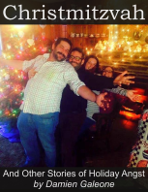
Late June 1348 was probably an ordinary English summer in Melcombe Regis. People were preparing for the Feast of St. John the Baptist, which is the half-year twin of Christmas: exactly 6 months later, summer solstice vs. winter, longest day of the year vs. the shortest, celebrating light instead of preparing for the dark. People made bonfires of different wildflowers and marched through town with banners. Newcomers to town put out tables in front of their homes with beer, cheese, and bread to greet neighbors. Nothing makes friends like cheese and beer.
During the festival, the ties binding the lower classes were purposefully loosened. Peasants and farmers lived a life of constant and endless toil, but if they didn’t piss off God they would spend an eternity in paradise after dying in misery at 38. But on the Feast of St. John, they were allowed to let down their hair, which took form in dancing, feasting, and drinking. This got rowdy, and worried officials watched for riots. Partially relieving tension were violent sports such as mob football, which involved uncounted players trying to carry an inflated pig’s bladder across a marker ‘by any means necessary’. The proceedings led to gouged out eyes, broken limbs, and a death or two. Think MMA, but with less TV coverage and in a Russian gulag.
As a harbor town, the inhabitants of Melcombe Regis were used to strangers in town. Soldiers, sailors, prostitutes, and their syphilitic counterparts were probably a common sight. So when a couple of ships ported from Gascony on June 20 (or so), nobody would have noticed. It might have been sailors from a spice ship or soldiers returning from the Hundred Years’ War. Soon, however, it became clear that someone had brought something to shore. By June 23 the chronicle of the Franciscan Friars at King’s Lynn recorded that the men of Melcombe who had been infected by the sick seamen were dead, noting it had barely been three days. The Black Plague (aka the Great Mortality or the Great Pestilence) had entered England and would dominate life and society for the next two centuries.
I won’t go into the gory details of the Plague. The gist: everyone died – badly. The long-term effects of the Plague were unprecedented. For starters, there were a lot fewer people. Two million people had died, which equalled 40-50% of Britain, complete towns disappeared. It halted the Hundred Years’ War between France and England; when people were dying at home there was no reason to send them off to die in a foreign country. The Plague also changed the position of the lower class. Since everyone else was dead, the people who were left found they had something novel – bargaining power. Though the gentry tried to quell this newfound position of strength among the peasantry, the power of the market was stronger. Manpower was needed, manpower was scarce, living manpower could charge better wages. It’s estimated that incomes rose 250% from 1300-1450 (and in the U.S. about another $1.25 since then).
This meant a better quality of life for farmers and peasants. They had more money, which meant more expendable income. Common people began buying better home furnishings and tools (designer swages went wild on Amazon.me and people dropped some groats on a good auger bit). They suddenly had leisure time and in that time they wanted to eat better food and drink better ale. Moreover, having just seen family and friends die slowly, painfully, and to catchy children’s rhymes, the survivors decided that YOLO. Or, in terminology that may have been used then – carpe diem.
All of these factors led to the rise of the British pub.
Oh, beer and ale had been around for a long time in England. It was the center of many feasts and celebrations. Ales were also available at inns and out of homes in local communities. The women brewed ales in their homes and when they had leftover they sold it to the local community. They advertised this excess with an ale stake, a foliage-wrapped pole next to the door. At times, someone buying ale might come in to enjoy the fire or a bit of bread and cheese (i.e. making friends). This provides the roots for the common features of the British pub – cozy, homey, log fireplace, wooden beams, low ceiling. The quiz night and tracksuits came later.
With commoners suddenly with money and leisure time, a demand for better quality food and ale led communities to centralize and commercialize their public houses. Each town narrowed down their various home breweries to one or two public houses. This is where the locals gathered for good ale, good food, and games for entertainment. The British pub.
What to drink? Ale. Before the plague, the most common drink was ale, which was made with malted grains, water, and was fermented with yeast. Beer added hops, which changed the process, the resulting product, and the beer allegiances of millions of mustached hipsters. Medieval ale was probably not very tasty, so if you want to be historically accurate, get ready for a night of drinking a bathwater of light brown sadness. If you would like to recreate a medieval ale, there are some recipes here. Otherwise, we might suggest a cask ale. Cask-conditioned ale undergoes secondary fermentation in the barrel and it’s not pasteurized. The cask ale we chose is called Thwaites Wainwright, which is refreshing, straw-colored, and with soft fruit flavors, much like the medieval bard after whom it is clearly named. Drink to peasant survivors of the Plague, who not only attained leisure time for future generations, but showed us how to spend it.
